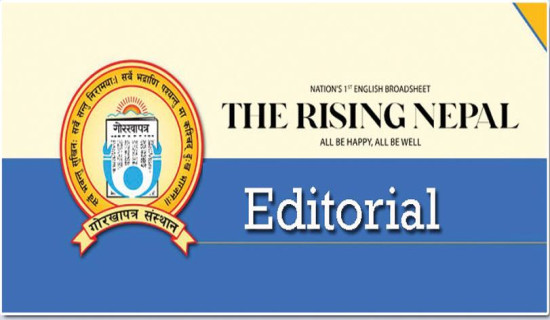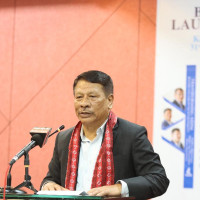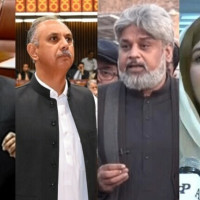- Friday, 1 August 2025
Digital Drive Nearing Normal
What the new information and communication technology has done and promises to do in the ensuing times is the key theme embraced in “Digital Paridrishya: Sanchar ra Patrakaritako Ayamik Parivartan” (Digital Landscape: Communication and Dimensional Change in Journalism) by Dr. Risihikesh Dahal, a faculty member for some two decades under the Tribhuvan University campuses, in addition to being a practising journalist of note. The book has nine chapters — all structurally well produced with content substantiated by appropriate facts, figures and citations. Perhaps the most comprehensive contribution from communication and academic standpoints on the subject, the chapters dwell upon various aspects of the internet era accelerated by the entry of Artificial Intelligence (AI).
The preface succinctly gives a fair idea of what the contents are, from Gutenberg in the mid-15th century through the launch of Gorkhapatra as Nepal’s first news publication in 1901 and after to the digital era, whose reach and influence impact societies all over. The topics are of meritorious value, and cover the changing mediascape, rapid spread of social media, the havoc created by fake accounts, online news portals, YouTube newsroom, digital crime and democracy, ethical questions and the law. Also brought up is the internet culture’s evolution and pace, now being supplemented by AI’s arrival, which should take social units by yet greater storm within the next few years.
Remarkable growth
The breakthrough in AI on the technological front pushes for a new era of common opportunities, offering vast space for individual initiatives and institutional achievements. The past can be created; the present can be catered to with new insights; and the future is promised yet more breakthroughs. The author presents a long line of online indicators, strewn with an impressive array of dates and data, together with substantive citations. Affordable costs of new instruments and gadgets should enable AI to blend into popular use.
Pushing the communication and other technological boundaries for content creation and delivery is an outcome of mindboggling proportions that human minds have attained. The growing use of social media gives an inkling of how social units at various levels are destined to be impacted. AI will make content creation even easier, access to information speedier and gadgets relatively affordable, which defines the service as essential for all types of people and groups. New communication and information technologies offer breathtaking opportunities for various genres of communication, but they also risk misinformation and disinformation that only distort facts and misguide people. Conventional journalism won’t work any longer. Changed conditions call for a new approach to journalism — fresh and niche content on a sharper scale. Habits die hard.
With the chip culture pacing fast, voice orders will soon do much of the work, extending individual comfort zones. Mysteries can be unravelled and intrigues decoded. Some scholars are dismayed over the revolutionised conditions that enable mischief makers to play havoc with public curiosity and social sensitivities. AI’s growing use and presence in the next decade will underscore this even more. Disinformation is the result of deliberate design to deceive someone.
Technology has given vast space and enormous choices, inviting sweeping changes, involving less physical presence but considerable audibility and more visibility, with options also for creativity. Digital expansion does not exactly displace but drastically undercuts legacy media that refuse to adapt to the new climes. Caution should be exercised against media oligarchy in the digital drive. The condition might erect stumbling blocks to proper information filtration for cohesive media understanding of important issues.
Divisive practices in the name of personal choices and social values can become rampant.
In his appraisal of the evolution, growth and impact of the digital age, Dahal interprets the internet as an essential element comparable to the basics of life like “food, shelter and clothing”, and cautions against fake information, which has always existed since time immemorial. But the 21st century’s conditions risk pandemic proportions if allowed to go unchecked by a democratic legal process. In the 1830s, the penny press was a revolutionary strategy that has lasted for almost 200 years.
That market strategy is no longer as effective today. Digital pay walls for valued content might turn out to be an option for news channels. Inadequate investment and less than free and fair journalism compromise content quality and its credibility. A respectable and successful digitalised drive denotes credible communication of accurate information, delivered earliest and with speed for generating public respect and earning revenue to at least meet operational costs. This might be easier said than done, but essential just the same.
Today, digitalised media are replacing legacy media. Issues ignored or overlooked by big legacy media houses find space and voice in core YouTube journalism and specialised outlets. Multi-channel legacy outlets are generally seen as mere extensions of their traditional incarnations. Hence, the approach should change for introducing new experiments in an era of relentlessly multi-pronged competition for audience attention.
Setting priorities
Social media serve as a fount of clues for follow-up and in-depth stories. In the process, the chances of rumours circulating as news soar. Computerisation and digitalisation have tremendously transformed the communication sphere. And yet more are destined to come in the ensuing media and communication ages. At the end of the day, or a specific time frame, content is what defines media quality, reach and staying power. An issue’s implications deserve special priority, with the larger community interests given the uppermost concentration and without adversely affecting individual social units’ basic interests. Whether an information service serves as mere narcotics or an enlightening platform is the big question.
Individual differences are not inhuman characteristics. But collective voices and cohesive understanding and undertaking of vital issues should not be given short shrift. Dahal’s online work in print sums up as an informative and insightful work — the best to my knowledge on the subject by any Nepali author, who has had well over two decades of hands-on experience in journalism. Keenly awaited are others to do even better and expand the horizon of this vital aspect of the communication sphere.
That the selective quality of the Centre for Media Research is associated with Dahal’s book as the publisher underscores a significant mulling point. Dahal periodically contributes articles to study journals. I have known him for nearly 25 years—when he was a Bachelor’s and Master’s student, followed by rubbing shoulders with me as a faculty colleague, and then as a PhD scholar under my supervision.
(Professor Kharel specialises in political communication.)
















